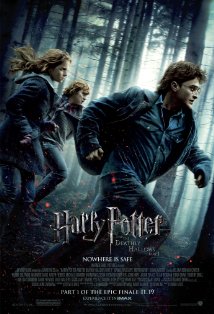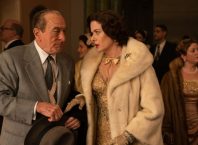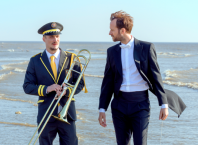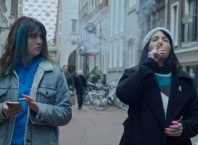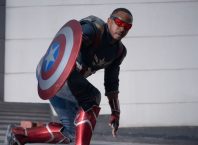Harry Potter and the Deathly Hollows Part 1′ begins with a brief sequence of two of our main characters saying goodbye to their childhood. Harry’s (Daniel Radcliffe) parting with his abusive relatives is hardly a sad occasion, but it represents the end of an era. Harry is saying goodbye to the thing in his life that has been a constant from childhood. Hermione’s (Emma Watson) goodbye, on the other hand, is devastating. No parting words are uttered, as she erases herself from her parents’ photographs and memories. It is time to put away childish things- they are saying goodbye to their homes and families, and for the first time in seven years are not leaving for the comforting halls of Hogwarts.
Not that they would find much comfort there- the formerly safe halls of Hogwarts are in the hands of Severus Snape (Alan Rickman), who has openly joined the Dark Lord Voldermort (Ralph Fiennes) after killing Albus Dumbledore (Michael Gambon in a very passive performance). Snape can now be seen standing idly by with the rest of the evil wizarding aristocracy as Voldermort tortures a Hogwarts teacher who dared to teach that it was not an abomination for wizards and muggles to mate (in a sickening sight, the teacher is suspended mid-air, bloodied and bruised, pleading for her life). Director David Yates is not shy about his use of imagery- the assembly of Voldermort’s minions look like nothing so much as an evil board-meeting discussing racial impurity and world domination- class warfare meets the Nazis. While these associations (taken from the novel) are not a theme of the movie (in the way Yates injected a very firm Orwellian subtext to the fifth film), they constantly pop up in the imagery, lending weight and raising the stakes in the build-up to the epic battle to come.
It doesn’t take long for the two sides to clash, as the Wizarding Resistance attempt at moving Harry to a safe-house results in a massive (and brief though it may be, impressively realized) air-battle. Dozens of Death Eaters descend on Harry and friends, half of whom are disguised as Harry, to act as decoys. The expedition succeeds in getting Harry to the safe-house (his friend Ron’s (Rupert Grint) house), but not without casualties. The rag-tag group of good wizards cannot protect him, so he sets out with Ron and Hermione, and only the vaguest notion of how to achieve the goal given to him by the late Dumbledore.
So on the three friends go (after a somewhat incongruous but welcome stop in downtown London), looking for clues as to the whereabouts of the remaining Horcruxes (pieces of Voldermort’s sword), as well as ways of destroying them. Now, seven is a nice strong number, but the notion of a different episode in order to first find then destroy each of the Horcruxes (two have already been destroyed, in parts 2 and 6) is a rather exhausting prospect- ennui sets in almost immediately. The audience is left just as confused and frustrated as the characters, only we happen to know that nothing too conclusive is going to take place by the end of this film –which is, after all, only part one. This fact of life cripples the film from a narrative stand-point, and Yates does his best to break through the apathy the audience develops by providing as many wonderful moments as possible. And by god, he comes very close to succeeding, providing a film that is both kind-of a mess and kind-of terrific.
Radcliffe, Watson and Grint have to carry more of the film than ever before- not being at Hogwarts, they’re journeying without the support of the all-star cast of actors from the British isles. They’re still there- but only very briefly (New additions to the crowded cast include Bill Nighy, Rhys Ifans, Peter Mullan and David O’Hara), and only a couple manage to carve out enough screen time to have an impact.. The young trio is better than ever here- from delivering the exposition that front-loads the film (which is far less annoying than it should be) to the emotional strains- Harry feeling the weight of people being hurt and killed to protect him, Ron feeling increasingly useless, Hermione torn between the two.
Yates embraces the new milieu of a Hogwarts-less Harry Potter, and uses the trio’s quest as an excuse to open up the film visually. A trademark of this film in this film is a wide, steady aerial shot of an unbelievably stunning and pristine vista, with our trio and their tent being a blip on the screen. This repeated visual motif both reminds us of the potential for beauty and calm, as well as underlining the Herculean proportions of the task ahead of the three tiny little figures. It’s a bit of a vague idea, but a lot rides on it, as it is the only element tying together the different mini-adventures in the film. What they’re up to and how to achieve it remains just as vague after mini-adventure #4 as it did at the beginning of the film. It is a frustrating rut that only gets solved by the Deus Ex Machina…which barely gets them back on track before the film ends.
With all those challenges, Yated took the only reasonable course, and continuted the trend of his previous efforts, as well as Alfonso Cuaron’s on pt. 3. He jettisons narrative in favor of emotion, ignores the big picture while spending all his efforts on the details. Getting those right, the big picture will handle itself (besides, he has pt. 2 to provide a narrative payoff).
From this film, I didn’t really know why I should care about Horcruxes and Deathly Hollows. But Peter Mullan’s (As Yaxley, a Death Eater) determined chase of Harry and friend –lasting all of a minute- across the Ministry of Magic’s main hall is the most thrilling chase scene I’ve seen this year. He cuts through the hall like a force of nature, with remarkable grace and menace. The death of a major character left me mostly unmoved- but Harry and Hermione’s dance to Nick Cave and The Bad Seed’s ‘O Children’ is the most wonderful and unexpected (sort of) platonic love scene. Harry’s visit to his birthplace -the place his parents died and this story started- falls flat. But a bit of exposition explaining the Deus Ex Machina that appears out of thin air at the 11th hour is a magical and haunting animation sequence that has absolutely nothing to do with the rest of the film tonally but is absolutely the best and most inventive thing in it. In fact, that CG shadow-animation sequence is probably the most breathtaking thing I’ve seen in cinemas all year (Credit for that sequence goes to Ben Hibon for the direction). The whole film may feel rushed, but Yates allows individual moments –be they shots, bits of movement, delivery, visual effects, score- the space to blossom into sublime cinematic moments.
Perhaps that’s setting this series a low standard. But where so many other mainstream film recycle, dumb-down, and settle for good enough –and at this point, these films hardly have to be good to make a fortune- I find it exhilirating to find a filmmaker who thinks in moments of film. A multi-million dollar movie made by some of the greatest craftsmen in film that only gets you from point A to B to C- that’s a waste. Invention and excitement and life in the moments –and the space to find them- that’s almost revolutionary. I greatly look forward to the culminating film, where the more focused narrative of the latter half of the novel should provide Yates and co. the optimal room to ace the micro as he did here, but the macro as well (as he did with the tighter story of ‘Order of the Phoenix’).
SHLOMO PORATH

